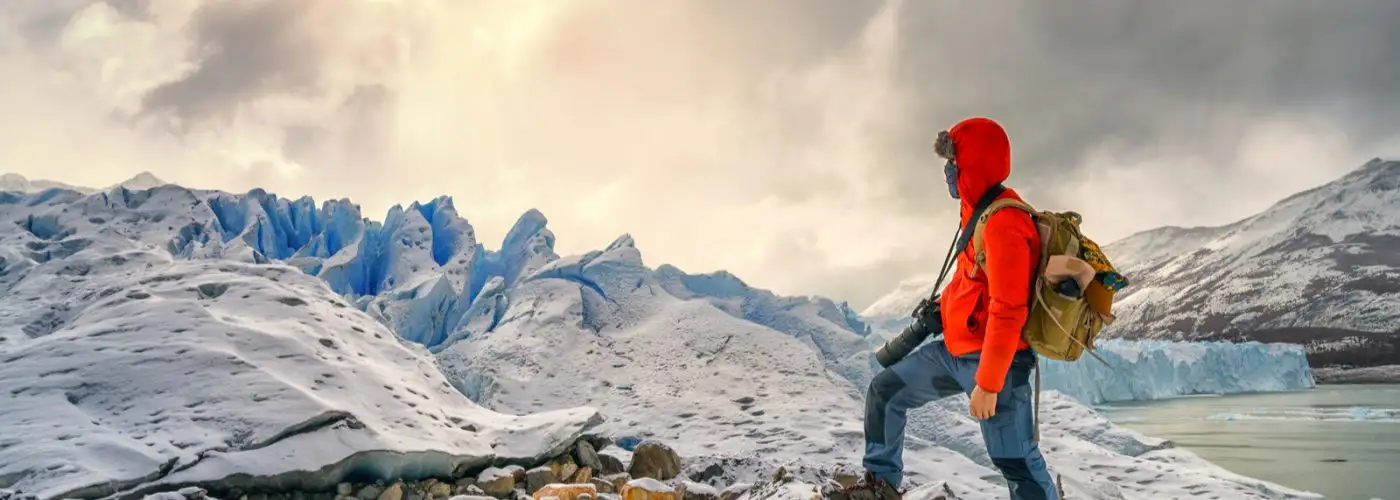There’s a famous saying that there’s no bad weather, only bad clothing. So if the frigid temperatures make you want to stay in your hotel room and watch Netflix instead of exploring outdoors on your vacation—don’t worry, it’s not you, it’s your clothing. I interviewed experts who face extreme temperatures in their jobs for tips on how to stay warm in the winter.
How to Stay Warm: Meet The Experts
Nicholas Bratton, co-owner of the Greenland-based arctic search and recovery company, Global Exploration and Recovery, knows how to stay warm, and can prove it: “I have over 20 years of experience climbing, working, and traveling in frigid environments – and I still have all my fingers and toes.” There’s no arguing with that.
Greg Thomsen knows a thing or two about winter clothing as well—he’s been in the outdoor industry for over 30 years, and is the Chief Outdoor Officer for adidas Outdoor USA.
How to Stay Warm: What to Wear
Your destination may only feel like it’s The Arctic, but the principles of how to dress are the same whenever you’re in cold weather. Bratton says “breathability in your clothing system is essential for keeping warm because it’s easier for your body to regulate its temperature when heat and moisture can escape efficiently.” He recommends starting with a stretchy, form-fitting, and moisture-wicking base layer. Add a hooded softshell jacket that has a thin fleece lining. On the bottom half, wear another thin and stretchy base layer topped with softshell pants.
Thomsen suggests that you complete the look with a thicker insulated layer that’s easy to take on and off as needed—either a synthetic fiberfill jacket or a down parka. “Layering lightweight, breathable and warm pieces together can help keep you comfortable in changing weather conditions without feeling too warm or cold. A big mistake for outdoor adventures is relying on heavy coats and apparel that is not easily packed away when adjusting to changing temperatures and activity levels. Lightweight packable layers are the way to go.”
How to Stay Warm: Save Your Fingers and Toes
On your hands, wear a thin wool liner underneath insulated gloves or mittens, depending on how cold it is. Mittens keep your hands warmer but make it harder to do tasks.
According to Thomsen, “choosing the right gloves with the right insulation, as well as a jacket with hand warmer pockets can help keep hands warm. Also remember that you will lose about 20 percent of your body warmth through your head, so wearing a hat will also help keep your fingers warmer.
To keep your feet comfortable, Bratton recommends “high-quality, thick merino wool socks inside insulated boots. I stopped wearing liner socks because they tended to bunch up and because wool sock technology is now so good that liners are no longer necessary for comfort or for performance.”
Wool Rules; Leave the Cotton at Home
Bratton advises to choose wool for your layers whenever possible. “The refinements in wool fabric technology have made this material a superior choice for cold weather use,” he says. “It’s more comfortable than synthetics in a wider range of temperatures, it’s more durable, it’s not as stinky after extended use, and environmentally it’s more sustainable. Wool used to have a reputation as being scratchy, but the newer wool base layers, socks, and insulation are amazingly comfortable. Wool clothes are a little more expensive, but they are a good investment because they last longer than synthetics. You spend extra up front but save more in the long run because you don’t need to replace them as often. I avoid cotton in cold weather.”
Don’t Forget to Hydrate (But Not with Coffee)
It’s easier to remember to drink water when you’re sweating, but it’s still important to hydrate in the cold, as you lose moisture through breathing and the drier air that usually accompanies colder temperatures. Bratton explains, “It’s easier for your body to circulate blood to your extremities when you’re hydrated, so keep drinking water. When it’s cold you may not feel like drinking, so make water more appealing by keeping it warm in an insulated bottle. Avoid drinking alcohol or caffeine. Alcohol is a vasodilator (makes your blood vessels expand), which causes your body to lose heat faster. Caffeine is a vasoconstrictor (shrinks your blood vessels), which makes it harder for blood to circulate. Both of them accelerate dehydration.”
More from SmarterTravel:
- How to Pack for a Winter Vacation
- 10 Winter Outfit Necessities for Travel
- 9 Packable Winter Jackets for 2018
Caroline Morse Teel lives in Boston, and has finally figured out how to stay warm in the winter. Follow her on Instagram @TravelWithCaroline for photos from Boston and around the world.
We hand-pick everything we recommend and select items through testing and reviews. Some products are sent to us free of charge with no incentive to offer a favorable review. We offer our unbiased opinions and do not accept compensation to review products. All items are in stock and prices are accurate at the time of publication. If you buy something through our links, we may earn a commission.
Related
Top Fares From
Today's Top Travel Deals
Brought to you by ShermansTravel
France: 8-Night Paris, Avignon & Nice...
Infinity Worldwide Vacations
 vacation
$2880+
vacation
$2880+
Poconos: 3 Nts in Garden of...
ResortsAndLodges.com
 hotel
$305+
hotel
$305+
7-Nt Canada & New England Cruise,...
Princess Cruises
 cruise
$839+
cruise
$839+




